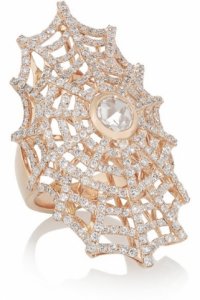Agnasia
Shiny_Rock
- Joined
- Feb 3, 2014
- Messages
- 465
I read this yesterday and thought I would share and see everyone's thoughts....
Marie Antoinette loved diamonds and there was a particular necklace that helped drive the French royals to catastrophe (it cost the equivalent of about £60m today). What is it about diamonds? The earth is full of other arguably more beautiful things such as the Burma ruby and Kashmir sapphire. Diamond appeal is to vanity and ambition, they hold sinister glamour in opposing associations of lust and respectability. Despite Kate Middleton's engagement ring, diamonds have kept a tight grip on the nearly-wed and the market did not change.
Diamonds reflect status such as the 35ct Beau Sancy diamond that dazzled like nothing seen before and made it an ultimate emblem of royalty. Big diamonds are still an emblem but not of royalty, at a charity auction in London the room was stuffed with silicone inflated wives dripping in flawless white rocks. Many people, usually men, treat diamonds like big yachts - to buy and then show off.
There must be more to diamonds than materialism, for thousands of years they haven been worshipped, stolen and fought over. The ancient Greeks thought they were the splinters of stars. Diamonds had always been rare although production increased in the 1720s with Brazilian mines and then again in the 1870s with the diamond rush of Southern Africa.
It was the beginning of the De Beers cartel that kept diamonds rare and expensive. The only way to increase the value of diamonds is to make them scarce. Another way was to increase the demand with the famous slogan "a diamond is forever". Before WW2 only 10% of engagement rings in America contained diamonds, by the late 1990s 80% did.
The two seismic shifts have been firstly with women buying their own diamonds (not engagement rings) and snapping up pieces such as a £26,000 rose-gold diamond spider's web ring by Anita Ko, a woman's hard earned treat to herself. The second is design, the big rock alone doesn't cut it, women want beautiful complex pieces dribbled with pave and wearable. It's about a more interesting setting now, being casual and more fun.
Unsurprisingly since women have taken a controlling stake in diamonds they've begun to look fascinating again. Marie Antoinette would have grabbed them by the handful and giggled with glee.
Marie Antoinette loved diamonds and there was a particular necklace that helped drive the French royals to catastrophe (it cost the equivalent of about £60m today). What is it about diamonds? The earth is full of other arguably more beautiful things such as the Burma ruby and Kashmir sapphire. Diamond appeal is to vanity and ambition, they hold sinister glamour in opposing associations of lust and respectability. Despite Kate Middleton's engagement ring, diamonds have kept a tight grip on the nearly-wed and the market did not change.
Diamonds reflect status such as the 35ct Beau Sancy diamond that dazzled like nothing seen before and made it an ultimate emblem of royalty. Big diamonds are still an emblem but not of royalty, at a charity auction in London the room was stuffed with silicone inflated wives dripping in flawless white rocks. Many people, usually men, treat diamonds like big yachts - to buy and then show off.
There must be more to diamonds than materialism, for thousands of years they haven been worshipped, stolen and fought over. The ancient Greeks thought they were the splinters of stars. Diamonds had always been rare although production increased in the 1720s with Brazilian mines and then again in the 1870s with the diamond rush of Southern Africa.
It was the beginning of the De Beers cartel that kept diamonds rare and expensive. The only way to increase the value of diamonds is to make them scarce. Another way was to increase the demand with the famous slogan "a diamond is forever". Before WW2 only 10% of engagement rings in America contained diamonds, by the late 1990s 80% did.
The two seismic shifts have been firstly with women buying their own diamonds (not engagement rings) and snapping up pieces such as a £26,000 rose-gold diamond spider's web ring by Anita Ko, a woman's hard earned treat to herself. The second is design, the big rock alone doesn't cut it, women want beautiful complex pieces dribbled with pave and wearable. It's about a more interesting setting now, being casual and more fun.
Unsurprisingly since women have taken a controlling stake in diamonds they've begun to look fascinating again. Marie Antoinette would have grabbed them by the handful and giggled with glee.






300x240.png)